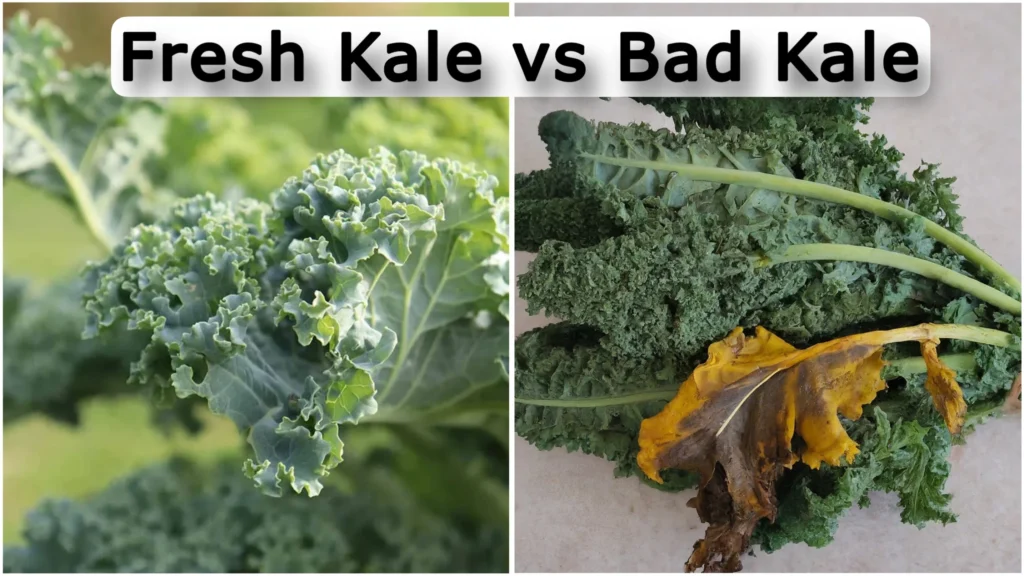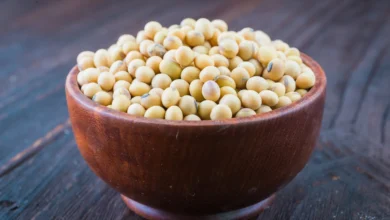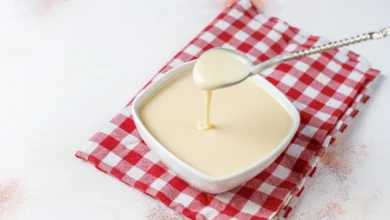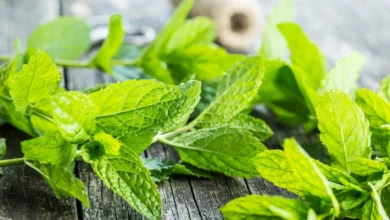Is Your Kale Still Good to Eat?
My heart sank as I pulled the kale from the fridge. It wasn’t the vibrant green I’d bought days before; it was a sickly yellow, speckled with brown. Disaster! My girlfriend was due to arrive any minute, and the healthy, impressive meal I’d planned was now a wilted nightmare. Every guy knows that food poisoning is not the way to a girl’s heart.
Desperate, I started frantically searching online. How could I tell if this was just slightly aged kale or a full-blown health hazard? That’s when I discovered the telltale signs of bad kale, and it turns out my instincts were right – this bunch was sadly past its prime.
Contents
- How to Know if Kale is Bad…
- Can Kale Go Bad?
- What Causes Kale to Go Bad
- How to Tell if Kale Has Gone Bad
- Freshness Check: Feel, Look, and Smell
- Is Slimy Kale Bad?
- Can You Eat Yellow Kale?
- Does Kale Smell Bad When Cooked?
- Types of Kale
- How to Pick Out Kale
- How Long Does Kale Last?
- How Long Will Kale Last on the Counter?
- How Long Will Kale Last in the Fridge?
- Should I Wash Kale Before Putting It In the Fridge?
- How to Store Kale
- Can You Freeze Kale and How?
- Kale and Food Safety: Handling with Care
- Health Benefits of Eating Kale
- Recipe Spotlight: Kale Chickpea Salad
- Frequently Asked Questions
How to Know if Kale is Bad…
Knowing that kale has gone bad is challenging. So, let’s discover the signs of bad kale, and how to use it properly!
Can Kale Go Bad?
Absolutely, kale can go bad! There’s a bit of a common misconception that kale, being such a hearty vegetable, can last forever. While it’s true that kale tends to be tougher than some other leafy greens, it’s still a cruciferous vegetable with a limited shelf life.
The good news is that you can definitely extend how long your kale stays fresh by storing it correctly. Even better, consider freezing prepped kale for use in future smoothies or soups!
What Causes Kale to Go Bad
Like all fresh vegetables, several factors can contribute to kale going bad. Thankfully, there are some telltale signs to look for that will help you avoid consuming expired kale:
- Excess moisture: When stored wet or in a humid environment, kale can become slimy. This sliminess often indicates it’s starting to spoil. This happened to me once, and it taught me the importance of properly drying those leaves before storing them!
- Improper storage: Kale needs space and proper airflow to last longer. If I forget proper storage practices, it tends to wilt and get mushy faster.
- Expiration Date: While not a guarantee, checking the printed expiration dates on pre-packaged kale is a good starting point. Even if you follow storage guidelines, your kale can go bad before the expiration date.
How to Tell if Kale Has Gone Bad
Knowing the telltale signs of spoiled kale is crucial to determine if it’s still safe to eat. Here are the top signs of spoilage to look out for:
- Black spots or brown spots: These are clear indicators of decay and mean your kale is past its prime.
- Slimy kale: If the leaves feel slimy or have a slippery texture, it’s a sign that the kale has started to go bad. This often happens due to the growth of harmful bacteria.
- Off smell or foul odor: Fresh kale has a mild, earthy smell. Any unpleasant smell, sometimes even a fishy odor, indicates the kale is no longer fresh and should be discarded to avoid potential food poisoning.
- Yellow kale: While yellowing leaves often mean the kale is simply getting less fresh, when combined with wilting, it signals it’s time to say goodbye to the bunch.
- Black specs or other discolorations: These could be signs of mold or other bacterial growth and should be avoided.
- Rotten eggs smell: A smell of rotten eggs is a significant red flag that the kale has gone bad and must be discarded.
In general, when your kale looks and smells off, it’s best to err on the side of caution and throw it out. Trust your instincts –it’s better to be safe than sorry!
Here is the visual representation of Fresh Kale vs. Bad Kale!


Freshness Check: Feel, Look, and Smell
- Texture Matters: Kale leaves should be crisp and firm to the touch. Wilting, sliminess, or mushiness are sure signs that the kale has gone bad.
- Inspect the Color: Look for a vibrant, deep green color. Yellowing, browning, or the presence of dark spots indicate spoilage.
- The Smell Test: Fresh kale has a mild, earthy scent. If your kale smells sour, off-putting, or like rotten vegetables, discard it immediately.
Keep it Dry for Maximum Lifespan: Moisture is the enemy of fresh kale. To maximize its shelf-life, make sure your kale is completely dry before storing it.
READ: Can You Freeze Risotto
Is Slimy Kale Bad?
Yes, slimy kale is generally considered bad kale. When you pull those kale leaves from your fridge and discover they feel slimy, it’s definitely time to pause and evaluate. While it’s tempting to try to salvage the bunch by rinsing or trimming, here’s the breakdown:
- Serving Raw: Slimy kale is a no-go for raw consumption like salads or smoothies.
- Cooking: Sometimes, you might be able to remove the slimy edges and cut off the worst parts if the majority of the bunch still seems okay. However, there’s always a risk that contamination has spread even if you can’t see it.
Bottom Line: If your kale is significantly slimy, it’s safest to sadly dispose of the whole bunch. Trying to salvage it isn’t worth risking getting sick!
Can You Eat Yellow Kale?
Yes, you can eat yellow kale, but it’s important to understand why it has turned yellow in the first place. Sometimes you might find your kale turned yellow in the fridge, here’s why:
Why Kale Turns Yellow
There are several reasons why kale leaves might turn yellow:
- Aging: Yellowing can simply be a sign that your crop has gotten old. As the leaves age, chlorophyll (the pigment responsible for the green color) breaks down naturally. You might notice this if you’ve stored kale in the refrigerator for too long.
- Stress: Environmental factors like improper storage, lack of sunlight, or nutrient deficiencies can also cause kale to yellow.
While yellowing kale is generally safe, it may have a slightly bitter and tougher flavor compared to fresh, green kale. If possible, it’s best to avoid using extensively yellowed kale in raw preparations like salads. Instead, incorporate it into cooked dishes like soups, stews, or sautés where the flavor difference is less noticeable. The cooking process can help soften the leaves.
Does Kale Smell Bad When Cooked?
Kale naturally contains sulfur compounds that can release a slightly unpleasant odor during the initial stages of cooking, sometimes described as a faint rotten egg smell. Rest assured, this smell is normal and typically dissipates as the kale cooks. To minimize this effect, avoid overcooking your kale. Steaming, sautéing, or roasting for shorter periods helps preserve both the vibrant flavor and valuable nutrients.
What Happens If You Eat Bad Kale?
While eating slightly old kale might just cause an unpleasant taste, consuming truly spoiled kale carries some potential risks. Here’s what you need to keep in mind:
- Foodborne Illness: The growth of harmful bacteria in spoiled kale can cause symptoms of food poisoning, such as nausea, vomiting, or diarrhea. It’s essential to be vigilant about the signs of bad kale discussed earlier to reduce this risk.
- Digestive Issues: Even if the kale isn’t contaminated enough to cause food poisoning, eating slimy or wilted kale can contribute to stomach upset or digestive discomfort for some individuals.
Bottom Line: While kale is generally safe and healthy, it’s best to err on the side of caution if you suspect your kale has gone bad. Eating the freshest kale possible will help ensure the best taste, texture, and avoid any potential negative consequences.
READ: Fresh Oregano Pesto Recipe
Types of Kale
Kale’s popularity as a leafy green vegetable is no fluke – this green superfood truly is as nutritious as it is delicious! As a recipe developer, I’ve experimented with several different types of kale, each adding unique appeal to my recipes. Let’s explore some common varieties you might find at your grocery store or farmers market:
- Tuscan kale (Lacinato kale, dinosaur kale): Identified by its dark green, elongated leaves with a slightly wrinkled texture. It offers a sweeter, milder flavor that works beautifully in soups, stews, green smoothies, or even salads.
- Curly kale: The most common type, it features vibrant green (sometimes purple) ruffled leaves. Curly kale has a slightly bitter taste and chewy texture that stands up well in smoothies, salads, stir-fries, or when baked into kale chips.
- Red Russian kale: This eye-catching variety boasts flat, oval-shaped leaves with a striking purplish-red color. It’s one of the most tender varieties with a slightly sweet flavor, making it ideal for salads or sautéed dishes.
- Winterbor kale: You’ll spot this variety with its deeply curled, blue-green leaves. Winterbor kale has a sweeter taste and works superbly for a kale salad or as a flavorful garnish.
- Premier kale: Featuring smooth, flat, deep green leaves, this kale boasts a mild, approachable flavor perfect for salads and smoothies.
Additional Varieties
- Baby Kale: Simply young leaves of any kale variety, known for tenderness and mild flavor.
- Redbor Kale: Intensely ruffled with deep purple-red leaves. Primarily an ornamental variety, but edible with a slightly bolder flavor than standard curly kale
Kale Variations Comparison Table
| Variety | Appearance | Flavor Profile | Storage Considerations |
| Curly Kale | Tightly curled, vibrant green leaves | Robust, earthy | Hearty, tolerates longer storage, versatile |
| Lacinato Kale | Flat, elongated, blue-green leaves | Sweet, delicate | Shorter storage lifespan, ideal for raw or quick cooking |
| Red Russian Kale | Grey-green leaves, red-purple stem | Sweet, nutty | Similar to curly kale in storage potential |
| Winterbor Kale | Deep green, very curly leaves | Robust | Numerous crevices require careful cleaning and drying |
| Premier Kale | Deep green, moderate curl | Mild, tender | Shorter lifespan, best for fresh eating |
How to Pick Out Kale
Knowing how to pick out the freshest, most high-quality kale is key for bringing out its best in your recipes. Here are my top tips for how to select the perfect bunch:
- Vibrant Color: Look for kale with a rich, deep green color. Avoid bunches with any yellowed or brown spots or wilted leaves, as these are signs of age and deterioration.
- Leaves: Inspect the leaves for damage. Fresh leaves will be crisp and firm, free from blemishes, holes, or any torn or bruised areas.
- Size: Smaller leaves are usually more tender and have a milder flavor. Larger leaves can be tougher with a stronger taste. Keep your preferences and recipe requirements in mind when choosing.
- Inspect the Stems: Opt for bunches with stems that aren’t overly tough or fibrous. Thinner stems generally indicate a more tender texture. If your recipe calls for you to remove the stem, this is less of a concern.
- Organic vs. Conventional: If you’re looking to minimize your exposure to pesticides and chemicals, consider buying organic kale. Grocery stores and farmers markets will carry options.
- Freshness Matters: Kale is best in terms of flavor and nutritional value when it’s recently harvested. Buying kale at farmers’ markets means it’s more likely to have been harvested the same day or within a day or two.
- Seasonal Availability: Kale thrives as a cool-season vegetable, making its peak season in the fall and early winter months. While it may be available year-round, you’ll find superior quality during this time.
How Long Does Kale Last?
Kale boasts a relatively long shelf life compared to many other leafy greens. However, how long it stays fresh ultimately depends on how well you store it. When stored properly in your refrigerator, you can expect your kale to maintain its quality for up to a week. Some sources may even say five to seven days.
To extend the life of your kale, wrap the leaves in a slightly damp paper towel and then place them in a plastic bag. This combination of moisture and airflow will help keep the kale hydrated and crisp without becoming overly wet.
How Long Will Kale Last on the Counter?
In my experience, kale will last on the counter for a relatively short period of time compared to storing it in the refrigerator. Fresh kale maintains its best quality at room temperature for 1 to 2 days. After that, you’ll likely start to notice signs of wilting or deterioration. To get the most from your kale, it’s always best to refrigerate it as soon as possible.
How Long Will Kale Last in the Fridge?
To truly prolong the freshness of your kale, storing it in the refrigerator is the way to go! With proper storage practices, you can help your kale stay crisp and flavorful for up to a week.
Here’s the ideal method: Wrap the kale leaves loosely in slightly damp paper towels and place them within a plastic bag or airtight container in the crisper drawer. This provides the right amount of moisture and airflow for the longest shelf life.
For even longer storage, consider freezing your kale! Prepped and blanched kale can last for several months in the freezer, giving you the option to enjoy this nutritious green all year round.
Should I Wash Kale Before Putting It In the Fridge?
While opinions may vary, it’s generally recommended to wash kale before putting it in the fridge, even for an unopened bag of pre-washed kale. There’s always a chance that the produce could have come into contact with harmful bacteria during harvesting or processing. Thoroughly washing your kale before storage can reduce this risk.
Here’s how to wash your kale effectively:
- Prepare: Fill a large bowl or your clean sink with cold water. Adding a few ice cubes to create an ice water bath will help keep those leaves crisp and vibrant.
- Submerge: Fully submerge the kale leaves in the water and gently swish them around to remove any dirt or debris.
- Dry Thoroughly: If you have a salad spinner, use it to efficiently remove excess water. Otherwise, spread the leaves in a single layer on a baking sheet lined with paper towels and pat them dry. Proper drying is crucial for preventing premature spoilage!
Saving Time: Pre-washing and drying your kale saves time when you’re ready to use it in your recipes.
Different Types, Different Techniques: While washing is generally advised, the techniques may need adjustment depending on where the kale came from (your garden vs. store-bought).
How to Store Kale
Proper storage techniques are essential to maintain the best quality and keep your kale as fresh as possible. Here are my top tips for how to store kale:
- Remove damaged or wilted leaves: Before storing, sort through your kale and discard any leaves that show signs of damage or wilting.
- Rinse thoroughly: Wash your kale under cold water to remove dirt or debris.
- Pat dry: Dry the leaves thoroughly using paper towels, or a salad spinner if you have one.
- Airtight container or plastic bag: Store the dried kale in an airtight container or resealable plastic bag.
- Wrap for Moisture: Lightly wrap the kale in a slightly damp paper towel to absorb excess moisture. This will help keep leaves from becoming sticky.
- Back of the fridge: Place the kale in the back of your fridge where it’s generally the coldest, or in the crisper drawer which is designed to maintain humidity levels.
- Avoid room temperature: Prolonged exposure to room temperature will cause your kale to wilt and spoil quickly.
- Freezing excess kale: If you have more kale than you can use, freeze it in resealable freezer bags. Blanching before freezing will help retain its vibrant color and texture.
- Avoid Produce that Releases Ethylene Gas: Avoid storing kale near certain fruits and vegetables that produce ethylene gas, such as apples and bananas. Ethylene can ripen kale and spoil faster.
- Allow for Air Circulation: Don’t overpack your kale. Leave some space in the container or bag to allow air circulation and maintain freshness.
Storage Tips for Maximum Freshness
To extend the life of your kale and ensure it stays crisp, follow these steps:
- Wash only when ready to use: Excess moisture speeds up decay. Store unwashed kale for optimal freshness.
- The paper towel trick: Wrap your kale loosely in dry paper towels. This absorbs any lingering moisture.
- Airtight is key: Place the wrapped kale in a resealable bag or an airtight container. Squeeze out excess air before closing.
- Crisper drawer for the win: Store your kale in the refrigerator’s crisper drawer, which maintains ideal humidity levels for leafy greens.
Can You Freeze Kale and How?
Absolutely! Frozen kale can last for up to 6 months in the freezer. Freezing kale is a fantastic way to preserve it for longer periods, extend its shelf life, and ensure you always have some on hand. Here’s how to do it right:
- Wash & Prepare: Start by thoroughly washing your kale to remove any dirt or contaminants. Remove the tough stems which can become fibrous when frozen.
- Blanch for Best Results: Blanching is key to preserve the color, flavor, and nutrients of your kale while also killing any potentially harmful bacteria. Prepare a large pot of boiling water and a bowl of ice water. Submerge the kale in the boiling water for 2–3 minutes and immediately transfer it to the ice water to cool rapidly.
- Drain & Dry: Once cooled, drain the kale thoroughly and pat it dry with paper towels or a clean kitchen cloth. Excess moisture can lead to ice crystals forming within the kale.
- Portion for Convenience: Divide your blanched and dried kale into portions based on how you usually use it in recipes. Consider chopping it into smaller pieces for easier use or leaving it whole. Place portions in airtight freezer-safe containers or sealable plastic bags, removing as much air as possible to prevent freezer burn.
- Label & Date: Label and date your packages of frozen kale before placing them in the freezer.
Frozen kale works wonderfully in a variety of dishes like soups, stews, smoothies, and stir-fries. While the texture may change slightly, its nutritional value is well-preserved.
Kale and Food Safety: Handling with Care
Kale is a nutrient powerhouse, but like any leafy green vegetable, it can harbor bacteria if not handled properly. Here are some key points to remember for safe kale consumption:
- Clean Hands are Essential: Make sure to wash your hands thoroughly with soap and warm water before and after handling kale.
- Washing is Key: Even if pre-washed, rinse kale just before using it, especially if some leaves appear damaged. Submerge it in a bowl of cool water, swish gently, and drain thoroughly.
- Separate and Sanitize: Use a clean cutting board and knife for chopping kale. If you’ve used the same board or knife for raw meat or poultry beforehand, wash and sanitize them thoroughly before using them with your kale.
Health Benefits of Eating Kale
As a home chef and recipe developer, I love adding kale to my recipes not only for its flavor but also because it’s a highly nutritious leafy green vegetable with numerous health benefits. Let’s dive into the key benefits of making this delicious food part of your healthy lifestyle:
- Good Source of Fiber: Fiber is essential for promoting healthy digestion and can help reduce the risk of certain diseases. A single cup of chopped kale packs a good amount of fiber!
- High in Vitamin C: This powerful antioxidant protects cells from damage and supports a healthy immune system. One cup of kale provides well over your recommended daily intake.
- Rich in Vitamin K: This vitamin is crucial for building healthy bones and aiding in proper blood clotting.
- Low in Calories: Kale is a great food for those looking to support weight loss or weight management. It’s filling yet low in calories.
- Nutrient-Dense: Kale offers a powerhouse of vitamins, minerals, and antioxidants in relatively small amounts. Eating this veggie regularly is an easy way to ensure you’re getting a variety of those essential nutrients for optimal health.
- Uses for the Whole Plant: Don’t throw out those stems – they’re edible! Cooking them can help you maximize your nutritional intake from this versatile plant.
When can you not eat kale?
- Kidney Stones: If you’re prone to oxalate-containing kidney stones, it’s wise to reduce your consumption of kale, as it’s high in oxalates. Whisk and Nibble suggests you to read from Swedish Health Services that how consumption of kale can cause kidney stone.
- Blood Thinners: Kale is packed with Vitamin K, which affects blood clotting. If you’re taking blood thinners like Coumadin (warfarin), consult your doctor or a registered dietitian before making big changes to your kale intake.
Recipe Spotlight: Kale Chickpea Salad
Kale’s nutritional benefits and robust flavor make it a wonderful base for salads. If you’re looking for a satisfying and healthy salad option, try a Kale Chickpea Salad. The combination of chickpeas, kale’s heartiness, and a flavorful dressing creates a delicious and filling meal.
Wrapping It Up
Kale truly earns its status as a superfood! From its versatility in the kitchen to its impressive nutritional profile, there are many reasons to incorporate this leafy green into your diet. Remember, choosing fresh kale, storing it properly, and being mindful of the signs of spoilage are key. With a little attention, you can keep kale tasting great and working for your health.
Now, it’s time to get creative! Whether you prefer it in a salad, smoothie, or cooked dish, there’s bound to be a kale recipe that’ll have you falling in love with this healthy and delicious vegetable.
______________________________
Frequently Asked Questions
Can I eat the stems of kale?
Yes! While the stems of mature kale can be tough, they’re perfectly edible and packed with nutrients. For tender stems, choose young kale or varieties like Lacinato. You can either chop them finely and cook them along with the leaves or save them for flavorful additions to broths and stocks.
How long does kale last in the fridge?
Properly stored kale can last for 5-7 days in the refrigerator. For maximum freshness, follow the storage tips mentioned earlier in the article.
Can I freeze kale?
Absolutely! Freezing is a great way to extend the life of kale. Blanching kale before freezing helps preserve its color and texture. Frozen kale can last for up to 6 months in the freezer.
What can I do with yellowing kale?
While slightly yellowed kale is safe to eat, the flavor might be a bit bitter. It’s best to use yellowing kale in dishes where its flavor can be masked, like smoothies, soups, or stews.
Is slimy kale safe to eat?
No, slimy kale is a sign of spoilage and should be discarded. Slimy texture indicates bacterial growth and can cause food poisoning.
How can I make kale taste better?
If you find kale too bitter, try massaging the leaves with a bit of olive oil and salt before cooking. This helps break down some of the toughness and mellows the flavor. You can also pair kale with flavorful ingredients like garlic, lemon, or a drizzle of balsamic vinegar.
Is it okay to eat kale that’s past its prime?
Older kale won’t necessarily make you sick, but it won’t taste great either. It often becomes bitter and loses its appealing texture. Avoid using it for salads, but you can try masking the flavor in cooked dishes or smoothies. However, if it’s slimy or has a bad smell, toss it – there’s a risk of harmful bacteria making it unsafe to eat.
Can you eat kale wrong?
While kale is incredibly healthy, overdoing it on raw kale can be an issue for some. Raw kale has compounds called oxalates, which can interfere with calcium absorption and might contribute to kidney stone formation in certain individuals. It’s best to have a mix of raw and cooked kale.
Does kale spoil easily?
Kale is relatively sturdy compared to some leafy greens. If stored properly (wrapped in a slightly damp paper towel in a plastic bag in the fridge), it can stay fresh for about 5–7 days.
Can I eat wilted kale?
You often can! Mildly wilted kale can be revived by soaking in cold water. However, if it’s slimy or has a foul smell, it’s time to discard it. Cooked dishes are the safest way to use wilted kale in case some bacteria has started to develop.





